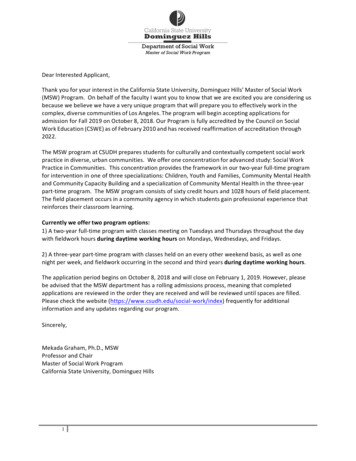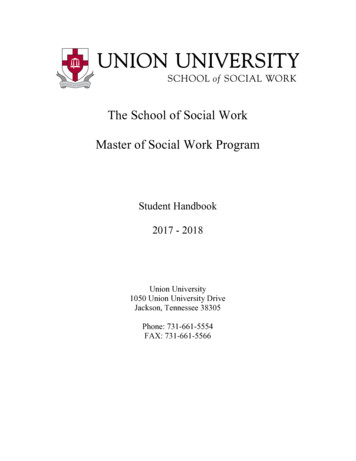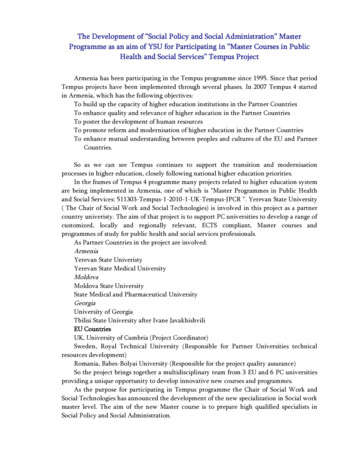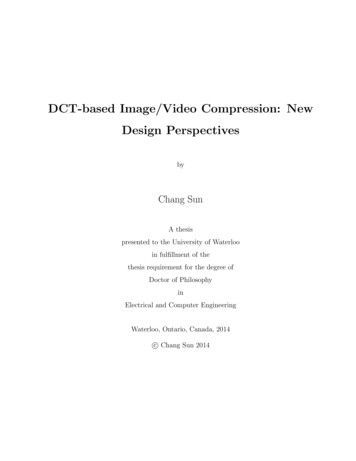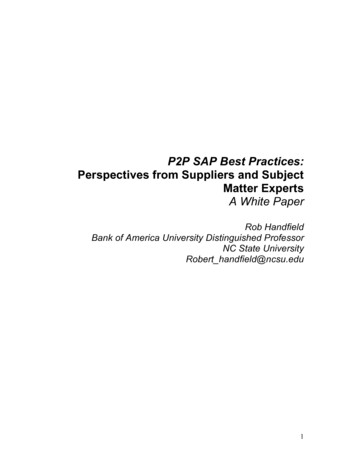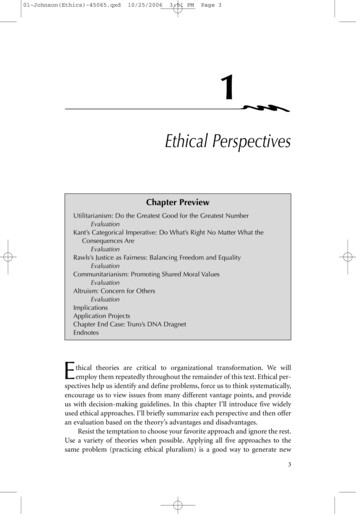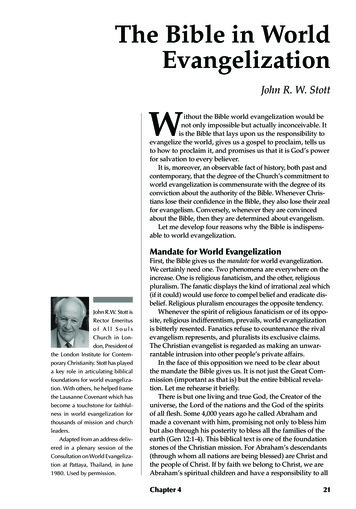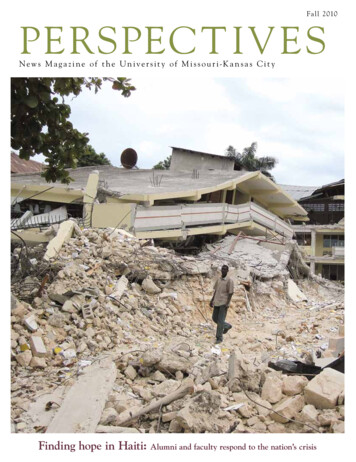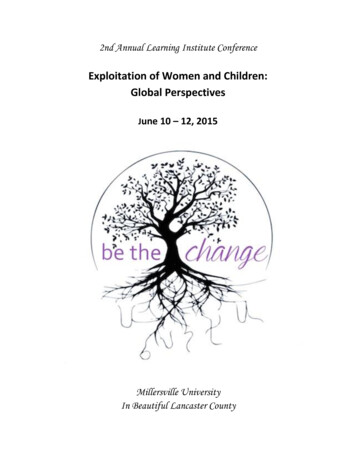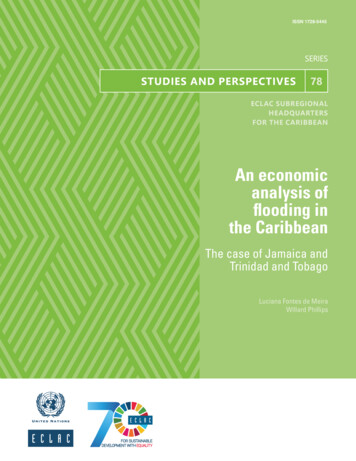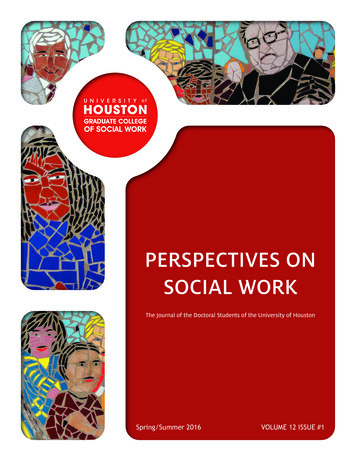
Transcription
PERSPECTIVES ONSOCIAL WORKThe Journal of the Doctoral Students of the University of HoustonSpring/Summer 2016VOLUME 12 ISSUE #1
Perspectives on Social WorkEditorMaurya W. Glaude, MSW, LCSWEditorial BoardTamara Al-RawwadChristine Bakos-BlockXin ChenYu “Jessica” MiaoPost-Doctoral ConsultantsRoberta Leal, Ph.D.Micki Washburn, Ph.D.External ReviewersKathryn ArnettUniversity of PennsylvaniaJacqueline BurseUniversity of Texas, ArlingtonHaipang ChenIndiana UniversityAnnie M. FrancisUNC, Chapel HillMichelle GricusUniversity of St. ThomasCole HooleyWashington University, St. LouisStephanie HowardHoward UniversityJamie HatzisAdelphi UniversityLin Helen JiangUniversity of DenverAndrea JosephUniversity of PittsburghElizabeth KiehneArizona State UniversityYoun Kyoung KimUniversity of Texas, ArlingtonSandra LeottiPortland State UniversityAngela LieberFlorida State UniversityTheresa MoranFordham UniversityHelen NicholsUniversity of MarylandLauren McInroyUniversity of TorontoScott D. SaintoUniversity of Texas, ArlingtonTina SimmsUniversity of MinnesotaKristin SmythUniversity of South FloridaRusty SouleymanovUniversity of TorontoAbigail WilliamsUniversity of MichiganKatherine WilliamsLoyola University, ChicagoFaculty SponsorSheara Williams Jennings, Ph.D.Graduate AssistantNatalie Wilson2
3
Table of ContentsGuest Editorial - Social Justice in Social Work Practice and EducationSusan P. Robbins5Paradigms Found in Reunification ResearchMatthew A. Walsh, Indiana University School of Social Work7Fostering Research and Diversity Competencies for Students and Scholars:The Case of an Interdisciplinary Research SeminarElizabeth G. Holman, University of Illinois at Urbana-ChampaignMegan S. Paceley, University of Kansas15Theoretical Models of Adult Suicide Behavior Based on Psychodynamic andCognitive TheoryHeather Peterson, University of Texas, Arlington25Intersectional Social Work Perspectives on the Systemic Killing of Black MenDe’Shay Thomas, Arizona State University36Husain Lateef, Arizona UniversityTravis W. Cronin, Arizona UniversityDeveloping an Exercise Routine among People with Serious Mental Illness in theClubhouse Structured Exercise ProgramIngyu Moon, Simmons CollegeThe CV Builder4361Guidelines for Submissions634
Guest Editorial-Social Justice in Social Work Practice and EducationSince the beginning of the Progressive Era in the 20th century and the origins of the Settlement HouseMovement, social justice has been an ideal, a core value, and guiding principle for social work practice. Incontrast to the morally uplifting advice that was the mainstay of the earlier Charity Organization Society,social workers during this era were actively involved in advocacy for progressive social reforms and socialpolicy initiatives aimed at improving the living and working conditions of women, children, and newly arrivedimmigrant poor (Reisch, 2002; Robbins, in press). However, the profession’s commitment to social justice andprogressive social work that embodies those ideals has been inconsistent over the course of our history. AsReisch and Andrews (2001) have noted, our profession, both historically and currently, has promoted practicesthat essentially reinforce the status quo rather than promoting social justice. This tension between socialcontrol and social reform has been an ongoing issue in both practice and education.And, despite its centrality for social work, the concept of social justice can be seen from a variety ofperspectives and have multiple definitions, some of which run counter to the values of our profession (Austin,Branom & King, 2014). A general definition that is consistent with social work values holds that social justiceis “an abstract and strongly held social work ideal that all people should have equal rights to the resources of asociety and should expect and receive fair and equal treatment” (Heinonen & Spearman, 2001, p. 352).More explicitly and fully defined in the National Association of Social Workers Code of Ethics (2008)as one of our professions six ethical principles, the mandate that social workers “challenge social injustice”includes the following:Social workers pursue social change, particularly with and on behalf of vulnerable andoppressed individuals and groups of people. Social workers’ social change efforts are focusedprimarily on issues of poverty, unemployment, discrimination, and other forms of socialinjustice. These activities seek to promote sensitivity to and knowledge about oppression andcultural and ethnic diversity. Social workers strive to ensure access to needed information,services, and resources; equality of opportunity; and meaningful participation in decisionmaking for all people (para 15).In contrast, the Council on Social Work Education (2015), the organization responsible for overseeingaccreditation of social work programs in the United States, has expanded this to also include “advancinghuman rights and social, economic, and environmental justice” as one of the nine core competencies for socialwork education. This includes an understanding of “the global interconnections of oppression and humanrights violations” and knowledge about “theories of human need and social justice and strategies to promotesocial and economic justice and human rights (p.7). Given these varying definitions combined with extantresearch that has also found inconsistent definitions used by students, academics, field advisors, and socialworkers in practice, Morgaine (2014) suggested that “For social work to continue to utilize the language ofsocial justice, it is imperative ” that we “ engage with and extend these dialogues” (p. 6).Several developments in the 21st century have brought social justice ideals to the forefront of bothpractice and education. These include the Just Practice Framework proposed by Finn and Jacobson (2003;2008); alternative research models that support social justice practice; a growing interest in political socialwork, anti-oppressive practice, and structural social work practice; and an expansion of our theory base toinclude a broad variety of critical theory and the strengths perspective (Finn & Jacobson, 2003; Robbins inpress). These are all important and timely advances that help bring us back to the roots of our profession.Susan P. Robbins, Ph.D., LCSWProfessor, University of HoustonEditor-in-Chief, Journal of Social Work Education5
ReferencesAustin, M.J., Branom, C. & King, B. (2014). Searching for the meaning of social justice. In M. J.Austin (Ed.), Social Justice and social work (pp. 1-17). Thousand Oaks, CA: Sage.Council on Social Work Education (2015). Educational Policy and Accreditation Standards forBaccalaureate and Master’s Programs. Alexandria. VA: Author. Retrieved fromhttp://www.cswe.org/File.aspx?id 81660Finn, J.L. & Jacobson, M. (2003). Just practice: Steps toward a new social work paradigm. Journal ofSocial Work Education, 39 (1), 57-78.Finn, J. L. & Jacobson, M. (2008). Just practice: A social justice approach to social work. (2nd ed.)Peosta: IA: Eddie Bowers Publishing.Heinonen, T. & Spearman, L. (2001). (Eds). Social work practice: Problem solving and beyond.Toronto: Irwin Publishing.Morgaine, K. (2014). Conceptualizing social justice in social work. “Are social workers too boggeddown in the trees”? Journal of Social Justice, 4, 1-18.National Association of Social Workers (2008). Code of ethics of the National Association of SocialWorkers. Washington D.C.: Author. Retrieved from isch, M. (2002). Defining social justice in a socially unjust world. Families in Society: The Journal ofContemporary Human Services, 83(4), 343-354.Reisch, M. & Andrews, J. (2001). The road not taken: A history of radical social work in the UnitedStates. Philadelphia: Brunner-Routledge.Robbins, S. P. (in press). Oppression theory. In. F. J. Turner (Ed.), Social work treatment:Interlocking theoretical approaches (6th ed.). N.Y: Oxford University Press.Editorial Policy:Perspectives on Social Work is a publication of the doctoral students of the University of Houston, Graduate CollegeOf Social Work. Submissions are reviewed by external reviewers. Articles are edited by the editorial board with thestudent’s permission. Responsibility for the accuracy of the information contained rests solely with the individualauthors. Views expressed within each article belong to the authors and do not necessarily represent the views of theeditor, the Graduate College of Social Work, or the University of Houston. All inquiries and submissions should bedirected to:Perspectives on Social WorkGraduate College of Social WorkUniversity of HoustonHouston, TX 77204-4492swjourna@Central.UH.EDU6
Paradigms Found in Reunification ResearchMatthew A. Walsh, MSW, LSWAbstractWhen children are removed from their parents by the child welfare system, reunification isalmost always the initial goal and is actually the most likely scenario (U.S. Department ofHealth and Human Services [USDHHS], 2014). It is not surprising, then, that the process ofreunification is an important area of focus within child welfare research. As with all researchtopics, child welfare literature is shaped by the studies and the researchers that contribute to it.Those researchers, in turn, are shaped by their own individual paradigms or frameworks in thatthese paradigms influence the type of research questions that social work researchers attempt toanswer and the sources of data they use to do so. The paradigms of positivism, constructivism,and critical theory can be found in much of the reunification literature. The purpose of thispaper is to highlight that, while each paradigm has its own strength, a combination of all threeprovides the best research for explaining, understanding, and addressing the reunificationprocess as a whole. Individual studies are used to highlight this point.Keywords: paradigms, child welfare, reunification, positivism, constructivism, critical theoryThe child welfare system often focuses on reducing the time children spend in foster care prior toreunification without increasing reentry rates (USDHHS, 2014). It follows, then, that thereunification process and factors associated with successful reunifications are common andimportant topics within child welfare research. This research is shaped by those conducting it,who are, in turn, shaped by their own paradigms. With this is mind, child welfare studies on thetopic of reunification were reviewed with a particular focus on any underlining paradigms ofpositivism, constructivism, and critical theory. These paradigms have long been acknowledgedas having influence within research (Guba & Lincoln, 1994), and are still found in today’sresearch. Though each paradigm has its strengths, the purpose of this paper is to advocate formultiple paradigms to be used in conjunction with each other in order to deepen the researchsurrounding reunification. A deeper understanding of the people involved in reunification andthe issues they face will improve reunification practices. This paper will briefly outline thereunification process and how different paradigms are found within child welfare studies beforeadvocating for researchers to use a combination of those paradigms when contributing to childwelfare research.ReunificationThe U.S. Department of Health and Human Services (2012) lists several different typesof child maltreatment that result in a family having an open case with the child welfare systemincluding: neglect, physical abuse, psychological/emotional abuse, sexual abuse, and medicalneglect. Removal is required when there are safety concerns for the child. Upon removal,children are placed in foster care, relative care or kinship care, or a residential facility, dependingon the need. During the removal process, parents are involved in services, visitations, andregular court proceedings. Cases remain open until they are resolved; “resolution” could mean7
any of the following: reunification, termination of parental rights, or another permanency plansuch as guardianship or emancipation. While reunification with the family is the desiredoutcome after removal, safety takes precedent; if returning a child to the family of origin cannotsafely occur, alternatives are pursued (Indiana Department of Child Services [INDCS], 2014).Reunification is defined as a child being discharged from the foster care system in orderto return to the family of origin. This is the most common resolution when a family is involvedin the child welfare system; 51% of discharges in 2012, the latest year of available federal data(USDHHS, 2014), were reunifications. There are contributing factors that appear to aid inreunification outcomes. Some of these factors are personal characteristics of the parents, such asthe ability to trust service providers and control anger (Blakely & Hatcher, 2013). Otherpersonal characteristics relate to understanding change; the parents’ ability to seek change,understand why it is necessary, and then follow through to produce change, have been shown toincrease the chances of reunification (Talbot, 2008). A strong, positive support system may alsoaid in producing reunification (Lietz & Hodge, 2011; Lietz, Lacasse, & Cacciatore, 2011).The most influential factor in achieving reunification appears to be the parents’ ability tocomplete court-ordered services (D’Andrade & Nguyen, 2014; Talbot, 2008). However,previous studies have shown that successfully navigating services is a challenge for some parents(Blakely & Hatcher, 2013; Carnochan, Lee, & Austin, 2013; Lietz & Hodge, 2011; Lietz et al.,2011). Behavioral issues, mental health issues, and substance abuse are common challenges forparents involved in the child welfare system, while issues related to transportation, time, andintelligence also play a role in making it difficult for these parents to procure services(Carnochan et al., 2013; Lietz & Hodge, 2011; Lietz et al., 2011).The removal of a child or children from parents’ custody can be very traumatic forparents and can negatively impact how they view themselves (Blakey & Hatcher, 2013). Thismay be particularly difficult for mothers who incorporate their motherhood into their selfidentity (Wells, 2011). Feelings of anger, confusion, and hopelessness can all manifest duringthis removal process, and these emotions may compound with the initial issues that caused theremoval. Parents must then address most, if not all, of these concerns in a timely manner or runthe risk of losing custody of their children. This may lead some parents to doubt if they can, oreven should, get their children back (Blakely & Hatcher, 2013; Wells, 2011).ParadigmsReunification in a timely manner without risking reentry is the desired outcome of thechild welfare system (USDHHS, 2014); as such, this has been a focal point of child welfareresearch. This research includes studies that use both quantitative and qualitative approaches,focus on a variety of topics, and view the issues from differing perspectives. A search withinthis topic reveals studies that embody different paradigms; some focus on parents, children, orservice providers, while others focus on risk and protective factors. A researcher’s paradigmshapes his or her work, because it guides the researcher to ask certain questions and seek specificdata. A researcher conducting a study from a positivist paradigm will create a very differentdesign than a researcher operating from a constructivist or critical theorist perspective.8
PositivismPositivism was, at one point in time, the dominant worldview. It provided the socialsciences with many of the standards of rigor, such as objectivity, validity, reliability, andgeneralization that are still standards today (Glesne, 2010). However, positivism is widelycriticized for its assumption of a fixed reality that can be measured and understood (Glesne,2010; Guba, 1990; Padgett, 2008). Many studies that evaluate the effectiveness of child welfareprograms derive from the positivist paradigm, in that they seek to find that “true reality” throughrigorous controlled studies (Glesne, 2010; Guba, 1990; Padgett, 2008). These researchers seekto determine the effectiveness of the studied program and its impact on the issue (Brook,McDonald, & Yan, 2012; Chaffin, Hecht, Bard, Silovsky, & Beasley, 2012; D’Andrade &Nguyen, 2014). The results of these studies may then be used by the child welfare system toshape methods and practices used by services providers working for agencies or states. Theymay also provide important evidence to support programs already in place or ones being piloted.Without these studies, one would not be able to speak fully about the effectiveness of programslike the Strengthening Families Program (Brook et al., 2012) or how the use of targeted services,parenting classes, and counseling increases the likelihood of reunification (D’Andrade &Nguyen, 2014).Research derived from a positivist paradigm is useful but, at times, limited. For example,D’Andrade and Nguyen (2014) evaluated the effectiveness of using problem-targeted services,counseling, and parenting classes with parents seeking reunification. They found thatreunification rates increased as parents engaged and participated more in their referred services.This would appear to answer the research question and may satisfy those with a positivistperspective. Their findings raise an unanticipated question of whether the services werecompletely effective in addressing the concerns of the child welfare system or if caseworkerswere merely looking for compliance. Court reports reviewed by the research team revealed thatprogress and compliance were often reported together and were not distinguishable. This isalarming because one does not guarantee the other, though it is often be viewed this way,especially when looking at the results from a positivist perspective. Smith (2008) studied parentsand caseworkers’ perceptions of case plans and found that both view case plans as a list of tasksto be accomplished and as an end of itself rather than a means to create a desired change. Smith(2008) also found that referred services do not always align with what parents feel they need.These studies show that parents may not be fully engaged and invested in services aspotential change agents, which calls into question their true effectiveness. Even if the parent ismotivated to change, this cannot be ascertained strictly by looking at their attendance record.This raises the question of whether services are truly effective at reducing the targeted problemsthey are designed to address. Child welfare studies will assert their effectiveness, because theydo assist parents in achieving reunification, but a gap in the literature still exists; these familiesare not followed long term to determine if the issues reoccur. To fully determine if reunificationefforts were successful, one should follow the children throughout their childhood to monitor forreentry into the system or reoccurrence of maltreatment.9
ConstructivismConstructivism, as opposed to positivism, states that reality is socially constructed andthat multiple realities exist (Glesne, 2010; Guba, 1990; Padgett, 2008). Reality is not somethingthat is discovered as much as it is something that is formed by subjective experiences. The goalin constructivism research is to obtain a better understanding of the subject matter itself. Aconstructivist researcher hopes to provide context for, and an interpretation of, an issue by usinginductive reasoning while becoming a part of the research (Glesne, 2010). A constructivist studyon reunification would attempt to articulate the experience of parents having their childrenremoved and then reunifying.Parents involved in the child welfare system may see different solutions to their issuesthan their caseworker. They sometimes disagree on the services they are required to complete,as Shim and Haight (2006) fo
Howard University Adelphi University University of Denver . Clubhouse Structured Exercise Program Ingyu Moon, Simmons College 43 The CV Builder 61 . Matthew A. Walsh, MSW, LSW Abstract When children are removed from their parents by the child welfare system, reunification is .
